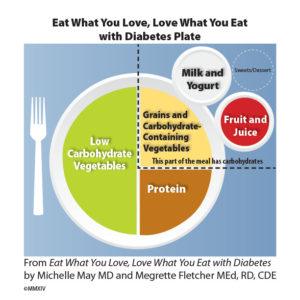When a person has prediabetes or diabetes, your body can’t process glucose efficiently. Therefore, it’s necessary to be mindful of the total amount of carbohydrates you eat at each meal or snack. Awareness of carbohydrates can help you begin to understand which foods cause your blood glucose levels to rise and which foods don’t. If you just told yourself “Carbs are bad!” or “I can’t have that!” it is likely you are stuck in a Restrictive Eating Cycle.
To learn more about the Restrictive Eating Cycle, read or re-read Chapter 1 of Eat What You Love, Love What You Eat with Diabetes. When we say mindful, it means being aware, not restrictive or critical.
The truth is, not all carbohydrates make blood glucose rise at the same rate. Foods that contain carbohydrates and fiber affect blood glucose levels differently than carbohydrates without fiber. Examples of fiber-rich foods are dried beans, like chickpeas and kidney beans, hummus or whole-grain bread with greater than 3 grams of fiber. These types of foods will likely affect your blood glucose differently than a lower fiber option. Fiber-rich fruits are typically ones that you also eat the seeds or skin such as all berries, apples, pears, peaches and plums. Juices like orange juice, canned fruit, or fruits like watermelon and bananas are lower in fiber because you are not eating the fiber-rich skin. All fruits contain carbohydrates. However, you may notice that the lower-fiber choices have a greater effect on your blood glucose levels.
 What is fiber exactly? Fiber is the indigestible portion of plants. It is not found in meat or animal products. You can add lots of fiber to your diet and very few carbohydrates by choosing to include more low-carbohydrate vegetables. If you are not sure what is a low-carbohydrate vegetable, there is a list on page 214 of Eat What You Love, Love What You Eat with Diabetes.
What is fiber exactly? Fiber is the indigestible portion of plants. It is not found in meat or animal products. You can add lots of fiber to your diet and very few carbohydrates by choosing to include more low-carbohydrate vegetables. If you are not sure what is a low-carbohydrate vegetable, there is a list on page 214 of Eat What You Love, Love What You Eat with Diabetes.
The Eat What You Love, Love What You Eat with Diabetes plate graphic can help you visualize where fiber is at a meal. (Download this handout: Mindful Meal Planning Using the Diabetes Plate.) Fiber-rich, the low-carbohydrate vegetables are represented on the left-hand side of the plate. These vegetables have less than 5 grams of carbohydrates per 1/2 cup cooked, 1 cup raw or 2 cups salad greens. They will also add 2 to 3 grams of fiber per serving and offer an amazing amount of vitamins and minerals like vitamin C, beta carotene, potassium and magnesium. The benefits of fiber are not just for blood sugar control. Eating a diet that is naturally high in fiber has been shown to lower blood pressure and cholesterol, reduce the risk of certain cancers (colon) and create a sense of fullness that can make meals more satisfying. Visually, fiber-rich foods often add color and texture to a meal while improving the meal’s overall nutritional quality. When you look at the benefits of eating more fiber, you can begin to see why we think fiber is a friend to carbohydrates.
